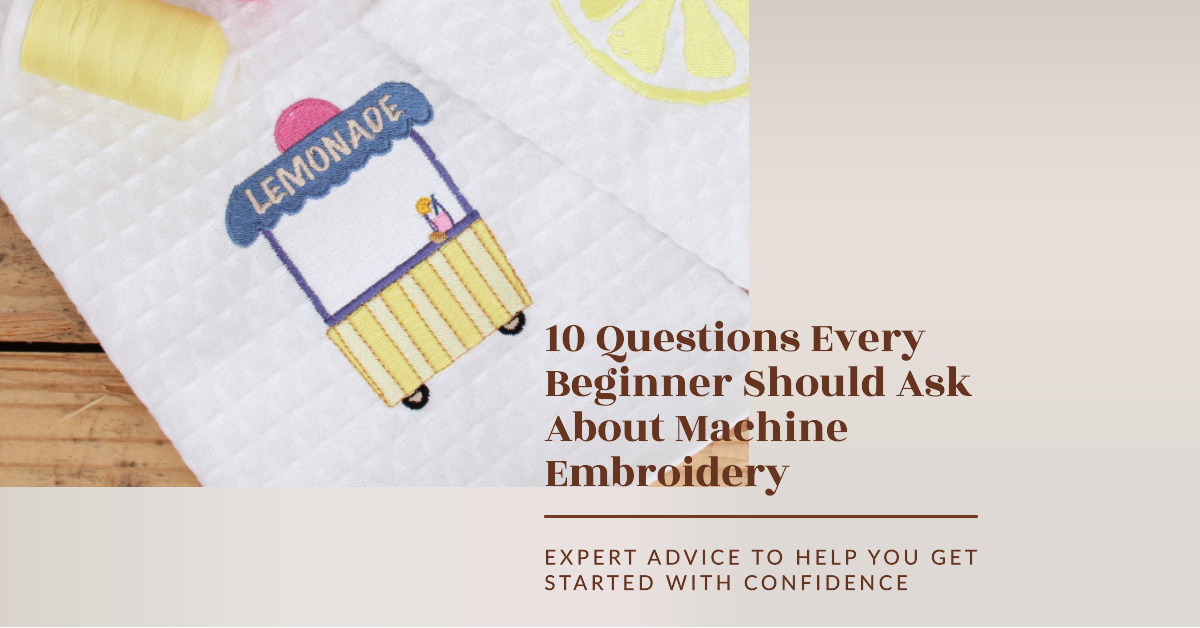
Machine Embroidery --10 Questions Every Beginner Should Ask
Embarking on Your Embroidery Journey: 10 Questions Every Beginner Should Ask
Embroidery is a wonderful craft that allows you to express your creativity and create beautiful designs on fabric. If you're just starting out in embroidery, you probably have a lot of questions. Here are ten questions every beginner embroiderer should ask, along with some helpful answers to get you started on your embroidery journey.
1. Which Thread Should I Choose?
The type of thread you choose is crucial for a successful embroidery project. Always opt for high-quality thread. Low-quality thread can make your design look subpar and even damage or weaken the materials you're working with. Consider the end-use of the item you're embroidering. High-sheen 40 weight polyester threads are best for most applications. Rayon threads are best for items that won't be exposed to harsh chemicals. Do your research to choose the best thread for your project.

2. Why Do I Need Stabilizer?
You need a stabilizer in machine embroidery to maintain the shape of your design, especially for more intricate designs or when working with stretchy materials like knits. Proper stabilization helps prevent issues like fraying, puckering, or designs warping out of shape after washing. It ensures that the fabric remains smooth and the embroidery looks remarkable. Stabilization is essential for achieving the perfect fabric tension, which is crucial for high-quality embroidery.
3. What Type of Fabric Should I Use?
When it comes to embroidery, fabric construction is more important than fiber content. Fabrics are generally categorized into woven or knit construction. Wovens are stable fabrics with a basket-weave pattern, while knits are stretchy and flexible. Most thread types work well on both fabrics, but knits and wovens have different requirements for backing stabilization and needle choice.
4. How Many Colors of Embroidery Thread Will I Need?
The number of colors of embroidery thread you will need depends on the design you're planning to embroider. If your design is simple and uses only one or two colors, then you will only need those specific colors of thread. However, if you're working on a more complex and colorful design, you may need a wider variety of colors. It's a good idea to have a basic set of colors on hand, including primary colors (red, blue, yellow), secondary colors (green, orange, purple), and neutrals (black, white, gray, brown) to start with. You can then add more specific shades as needed for your projects.
5. Why Does My Embroidery Look Bad?
Fraying or puckering in machine embroidery is often caused by using the wrong stabilizer. Proper stabilization helps maintain a smooth shape for intricate designs, especially on stretchy materials like knits. Another possible cause is using the wrong needle. Make sure you're using the correct needle for your fabric and thread, and replace your needle frequently to avoid dulling.
6. What Kind of Needle Should I Use?
Embroidery needles come in various sizes and points. Consider thread weight and fabric construction when choosing a needle. The 90/14 to 75/11 needle is commonly recommended for 40-weight thread. Machine needles come in ballpoints or sharps. Use the right point type for your fabric to avoid issues like cutting holes in stretchy knits or breaking needles on heavier fabrics.
7. What Type of Machine Is Needed For a Machine Embroidery Business?
There are many types of machines for commercial machine embroidery, from single-head machines for small businesses to multi-head machines for larger operations. Consider factors like design size, fabric thickness, and required speed and precision when choosing a machine. Multi-needle machines save time on color changes compared to single-needle machines.
8. How Do I Wash Embroidered Garments?
Wash embroidered garments in warm water with mild detergent. Avoid bleaching agents and don't leave damp or wet embroidered articles folded or stuck together. Don't wring out embroidered articles or leave them soaking in water. For commercially laundered items, use polyester thread. If leftover dry dye particles remain on the fabric after the first wash, rewash in warm water until they're gone.
9. Do I Need To Hoop?
Hooping is essential for machine embroidery. If a set of hoops did not come with your machine, you will need to purchase them. Learn to hoop different fabrics correctly with a suitable stabilizer for high-quality embroidery. Hoop with a stabilizer on the bottom and a garment on the top all at once. Adjust the tension screw for the right tightness. The material should be taut but not stretched. Choose your hoop based on your design and use the smallest one that fits the design.

10. What Should I Know About Machine Embroidery Designs?
-
Design Format: Different embroidery machines use different file formats for designs. Common formats include PES, DST, EXP, and more. Make sure the design you choose is compatible with your machine.
-
Design Size: Designs come in various sizes. Ensure the design fits within the embroidery area of your machine's hoop. Resizing a design too much can affect stitch density and the overall quality of the embroidery.
-
Stitch Count: The stitch count indicates the number of stitches in a design. Higher stitch counts usually mean more detail but also longer stitching times.
-
Color Changes: Some designs require multiple color changes. Make sure you have all the necessary thread colors before starting.
Machine embroidery is a rewarding craft that allows you to create beautiful designs on fabric. As you embark on your embroidery journey, keep these questions and answers in mind to help you create high-quality embroidery projects. Happy stitching!
